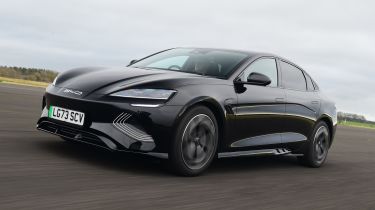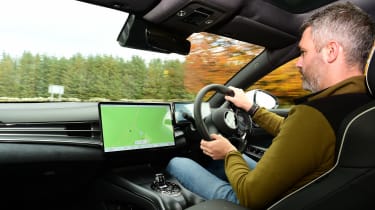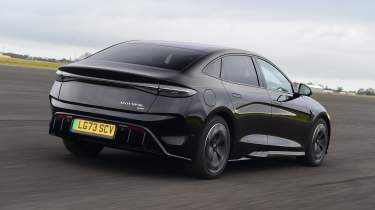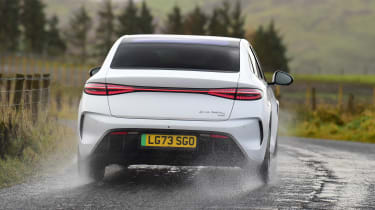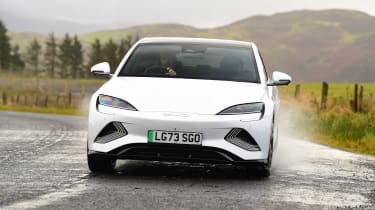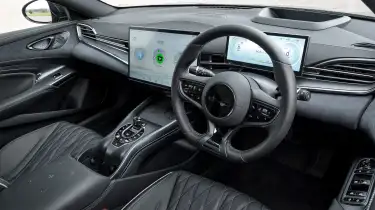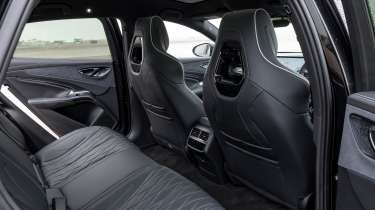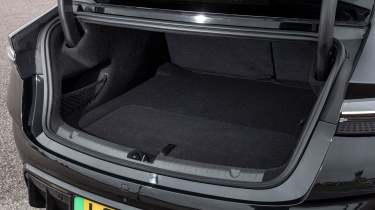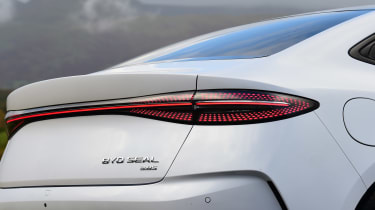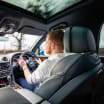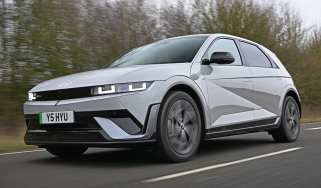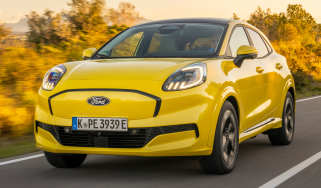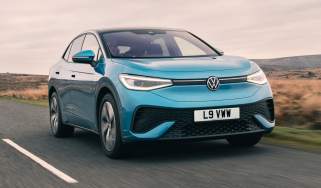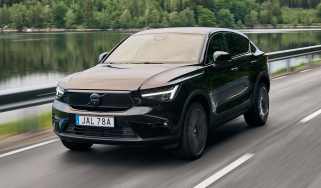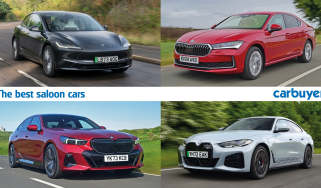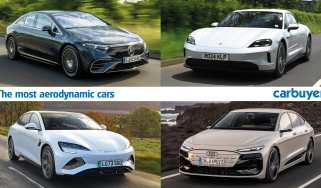BYD Seal review - long range and impressive cabin
“BYD’s Tesla Model 3 rival shows how quickly the brand is improving, with a long range and impressive cabin”
Pros
- Sleek looks
- Good to drive
- Strong range
Cons
- No hatchback
- Some cabin gimmicks
- Mixed ride quality
Verdict – is the BYD Seal a good car?
The third pillar of BYD’s range in Europe is very impressive. The base car is a little bit more expensive than a Tesla Model 3, but it’ll travel further on a single charge. It has the performance, styling and interior quality necessary to stay competitive in the electric car market, while the powerful infotainment system – with its novel rotating touchscreen – makes it a convincing rival for the most hi-tech cars in this class. The Atto 3 and Dolphin are both competitive offerings, but the Seal could be BYD’s best car yet.
BYD Seal models, specs and alternatives
So committed are manufacturers to SUVs both big and small that it’s almost a surprise when a brand debuts a conventional saloon or hatchback – which is exactly what Chinese firm BYD has done with its new Seal.
Joining the Atto 3 and Dolphin on sale in the UK, the Seal is a rather more premium offering from the brand that seeks to take on cars like the Hyundai Ioniq 6 or Tesla Model 3, or perhaps even the Porsche Taycan – a sleek and relatively low-slung saloon that prioritises range, performance and style over huge luggage space or a commanding driving position, with a starting price of just under £46,000. The problem is, those cars – particularly the Tesla – are much more familiar to buyers than the Seal, so it’s got to really impress to stand out.
 The 10 best electric cars in 2025
The 10 best electric cars in 2025
We tested the BYD Seal in a showdown up against five other electric company car rivals, but the Seal came out last in the pack. While it impressed us with its comprehensive list of standard kit, it wasn’t quite as polished as the Tesla Model 3, Polestar 2, Volkswagen ID.7, Hyundai Ioniq 6 or BMW i4.
One area where the BYD Seal does impress is in terms of aerodynamics and drag. It’s been designed with a low drag coefficient – that’s the amount of drag it produces which can hinder efficiency and therefore range while it’s pushing through the air. In fact, its drag coefficient is lower than that of a Tesla Model 3.
That means the rear-wheel drive entry-level Seal Design’s 83kWh battery pack will keep going for 354 miles according to official tests, while the dual-motor Seal Excellence-AWD cuts this to 323 miles in favour of superior straight-line performance – a distance we reckon is realistic after testing it in wintry conditions at the Lake District. We’re pretty sure most people will be satisfied enough with the Design’s 308bhp electric motor which is good for 0-62mph in just under six seconds – for even more speed, the 523bhp Excellence-AWD slashes it to a ballistic 3.8 seconds, which is a figure the brand flaunts with a badge on the bootlid.
Charging is similarly fast, courtesy of 150kW charging capabilities, enough to lift the Seal’s battery level from 10% to 80% in 37 minutes, while a heat pump helps preserve range even when the weather is cold by warming the cabin with less energy. A Comfort model will join the range later, with lower power and a shorter range, but this hasn’t yet been confirmed for the UK.
The Design model serving as the current entry point packs plenty of equipment already. The slightly gimmicky rotating infotainment screen – measuring 15.6 inches here – features, alongside a 10.25-inch driver display, 12-speaker Dynaudio stereo system, heated and cooled front seats, and “vehicle to load” capability – meaning you can power external devices using the car’s battery pack and a suitably chunky power lead. Six exterior colours and two interior trims are offered.
The starting price of around £45,000 for the Seal Design means it’s a few grand more expensive than the single-motor, rear-wheel drive Tesla Model 3, but the BYD will go around 50 miles more per charge. The Seal Excellence-AWD costs £3k more (roughly £48,000) but you get an extra motor and a good chunk more power for the money – there’s really not a lot else out there with a similar mix of qualities.
| Trim levels | Power options |
|
|
BYD Seal alternatives
Range, charging & running costs
Range is certainly one of the Seal’s strengths. All Seals use an 83kWh battery pack, which while not the biggest you’ll see on the market, is a touch larger than the long-range pack in a Hyundai Ioniq 6 and significantly greater than the roughly 60kWh pack of a basic Tesla Model 3.
Combined with a smooth and slippery body shape to reduce aerodynamic drag, the result is a range of 354 miles, nearly 50 miles more than an entry-level Model 3, and still better than the 338 miles of the longest-range Ioniq 6. Opt for the dual-motor Seal Excellence-AWD, and range drops slightly to 323 miles, but the real-world range of either model should cover the needs of most drivers. A standard heat pump will help to maximise that range even in colder weather too – it’s a way of heating the cabin that uses less energy.
During our test drive in a wintry Lake District, we found BYD’s predictions appear to be fairly accurate, with our trip computer showing a range of more than 200 miles with 65% charge remaining – despite the poor conditions. On this evidence, the Seal should be able to compete with the Tesla Model 3 for efficiency.
While 150kW charging capability should get the job done, it’s a way behind the Seal’s closest rivals: BYD claims a 30-80% charge takes 26 minutes (10-80% in 37 minutes), if you can find a suitably fast public charger, but we didn’t manage to achieve even half that speed when testing. Further to this, all models get an 11kW on-board AC charger so if you’ve got access to three-phase electricity, a full charge would be possible in less than nine hours; a more common 7kW wallbox will take close to 12 hours to charge from empty. The Seal has a CCS2 charging port.
| Model | Battery size | Range |
| BYD Seal Design | 83kWh | 354 miles |
| BYD Seal Excellence-AWD | 83kWh | 323 miles |
Electric motor, drive & performance
BYD currently offers two powertrain options for the Seal – it really boils down to whether you want one motor, which already provides plentiful performance, or two, which help to deliver rampant acceleration. The single-motor variant sees a 308bhp electric motor powering the rear wheels, while the dual-motor model, in Excellence-AWD trim, adds a front motor of slightly lower output, for a combined 523bhp.
While the performance is impressive, when we tested the Seal back to back against its main rivals, it failed to stand out in terms of driving feel. There’s a laggy feeling to the accelerator; put your foot down and it sets off modestly, then a few milliseconds later there’s a sudden push that pins you back in your seat – we’d rather its potential was unleashed a little more progressively. There’s a similarly odd feeling to the brakes, too, with a noticeable transition from regenerative and mechanical braking when you press down on the pedal.
Models fitted with the adaptive damper setup have the edge over many rivals in terms of ride comfort, particularly that of the Polestar 2. It feels as though the suspension carries the heavy weight of the Seal well, making it feel like a lighter car than it is, and while you’ll feel a jolt from larger potholes, it stays relatively comfortable on the whole. There’s a little body roll during more spirited driving through windy roads, but the Seal stays fairly balanced – it’s just a shame that the electronic stability control system can feel very intrusive at times, as you can feel it slowing things down when you push the car hard.
0-62mph and top speed
As you might imagine with outputs like that, neither Seal is short of performance. BYD quotes a 0-62mph time for the single-motor variant that’s just a fraction behind a single-motor Tesla Model 3 – while the dual-motor car uses its extra power and all-wheel drive traction to great effect, with claimed acceleration figures roughly splitting Tesla’s Long Range and Performance Model 3 variants.
After spending time in the rear-wheel drive model, we’d be surprised if you’d wish for anything more. It’ll swish to motorway speeds in no time, and it’s actually quite capable on country roads too, with a mix of good performance, keen steering responses, and a ride that isn’t too troubled by poor surfaces. Its steering is heavier than other BYD models we’ve driven so far, and you sit lower down, so it certainly feels like the most sporting car it has produced thus far.
The Excellence-AWD is certainly quicker but not necessarily better, thanks to a different suspension setup that results in a “pattering” feel over some surfaces, and steering that doesn’t feel quite as natural as the cheaper car, though if straight-line speed is your goal, you can probably put up with both of those complaints. We’d avoid Sport mode in either car, which makes the steering feel oddly over-assisted. Refinement though is more than competitive, with low levels of road and wind noise – and of course, the motor is nearly silent.
| Model | Power | 0-62mph | Top speed |
| BYD Seal Design | 308bhp | 5.9s | 112mph |
| BYD Seal Excellence-AWD | 523bhp | 3.8s | 112mph |
Interior & comfort
The quality of Chinese cars might have been a joke as little as a decade ago, but the Seal is one of those models that makes you appreciate how quickly Chinese cars have developed. Even by BYD’s recent standards, it’s another step in the right direction, with widespread use of tactile materials, soft-touch surfaces, and of course, a notable focus on infotainment.
Every Seal is quite lavish in its specification too, with kit including a long panoramic roof, quilted leather upholstery and a 12-speaker sound system from reputed manufacturer Dynaudio. That Dynaudio system offers great sound quality and really impressed us when we put it to the test, so the Seal might well be the right choice for audiophiles. The glass roof helps bathe the interior in light even in the British winter, double-glazed side windows help keep noise out of the cabin and the quality of materials feels good as you sit in the car and glide your fingers over its surfaces.
Infotainment and navigation
Step inside and the Seal’s dashboard has a clean, upmarket design, and is dominated by BYD’s now-expected 15.6-inch infotainment display – with the party trick/gimmick (you decide) of rotating between a landscape and a portrait layout. This and a 10.25-inch digital driver’s display look to be standard on all cars, but we’ll have access to the full trim structure and included kit from early 2024.
That said, having spent enough time in the car on both the European and UK launches, we can say with some confidence that the speed at which the infotainment responds to finger prods and voice commands via “Hey BYD” is impressive. It’s not without its faults, however; that rotating screen doesn’t have any tangible benefit, and if you’re using Apple CarPlay or Android Auto, then the heating controls disappear off the screen. That means you’ll have to navigate back to the home menu each time you want to change the temperature or fan speed – an issue we hope can be sorted with a software update in future.
Practicality & boot space
The Seal isn’t short of space. The clever battery placement means BYD has been able to get away with a lower, racier roofline without squeezing headroom for six-footers in the back, and a relatively long wheelbase (the distance between the front and rear wheels) has been beneficial for legroom too. The Seal feels like a far larger car than the Tesla Model 3, and it even puts the Hyundai Ioniq 6 in the shade if you want to carry adults in the back. It’s not perfect, though – stretch out in the rear and you’ll find the low-mounted front seats mean there isn’t much space for your feet to go under them.
The quiet and spacious cabin is a point in the Seal’s favour, which added to the car’s big battery and long range means you’ll rarely have to think hard about doing longer distances. If you do embark on a cross-country jaunt, those fast charging speeds should stand you in good stead.
| Size comparison | |||
| Model | Length | Width | Height |
| BYD Seal | 4,800mm | 1,875mm | 1,460mm |
| Tesla Model 3 | 4,694mm | 1,849mm | 1,443mm |
| Hyundai Ioniq 6 | 4,855mm | 1,880mm | 1,495mm |
| Polestar 2 | 4,606mm | 1,859mm | 1,473mm |
Boot space
The Seal is a traditional saloon rather than a large hatchback, which will ultimately compromise its practicality for some owners – but then its closest rivals, the Hyundai Ioniq 6 and Tesla Model 3, both use this format too. It goes without saying that any lack of boot access doesn’t appear to have harmed the Tesla’s sales figures. The Seal’s boot opening is similarly small to the Tesla, so the BMW i4’s hatchback wins here for UK buyers more used to a larger opening.
If the BYD’s 400 litres of boot space isn’t enough, there’s some underfloor storage, a ‘frunk’ under the bonnet for an extra 53 litres (more than enough space for stashing the car’s charging cables), and interior storage is generous too – the wireless charging pad, for instance, is big enough for a pair of phones to sit side by side.
| Boot space comparison | |
| Model | Boot space |
| BYD Seal | 400 litres |
| Tesla Model 3 | 425 litres (including frunk) |
| Hyundai Ioniq 6 | 401 litres |
| Polestar 2 | 405 litres |
Reliability & safety
The Seal is brand new, and BYD’s presence in the UK isn’t much older, so we’ve not yet got a solid handle on either the Seal’s dependability or BYD’s reputation for sales, service and quality. As such we can’t yet vouch for the Seal’s reliability, beyond BYD being a well-established brand in its home market, one with millions of vehicles under its belt – plus the usual caveats that mechanically, electric cars are quite simple and relatively low-maintenance compared to their combustion counterparts.
Build quality also seems good, which is a positive sign, while BYD’s standard six-year warranty, and eight years of cover for the battery and motor, should allay any worries for the first few owners at least.
Safety
Safety is now less of an unknown, thanks to a five-star score from independent crash-test body Euro NCAP. This matches the BYD Atto 3 and Dolphins’s five-star ratings in recent Euro NCAP crash tests. The Seal received scores of 89% and 87% for adult and child occupant protection, along with an impressive 82% for vulnerable road users.
The latter was boosted by a system designed to warn occupants against opening a door when a cyclist is detected approaching the car from the rear.
